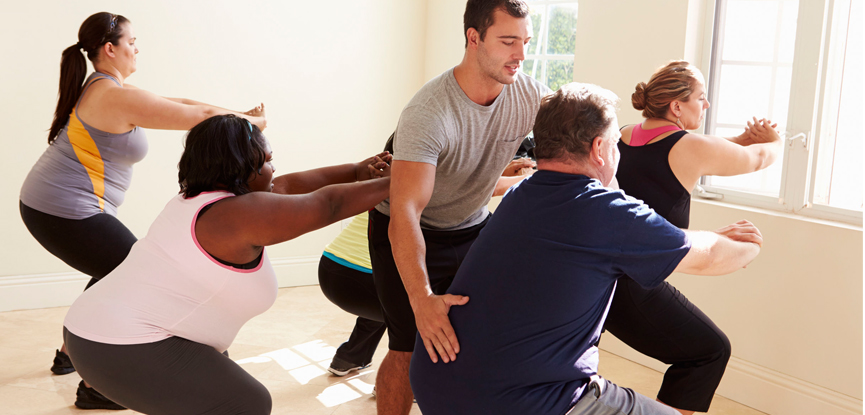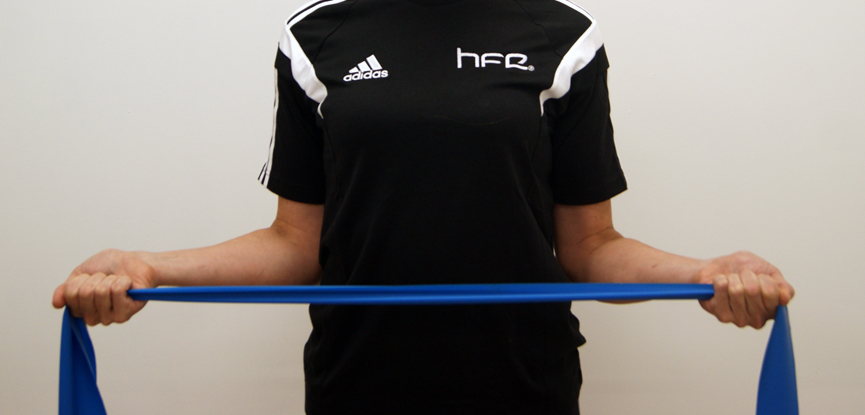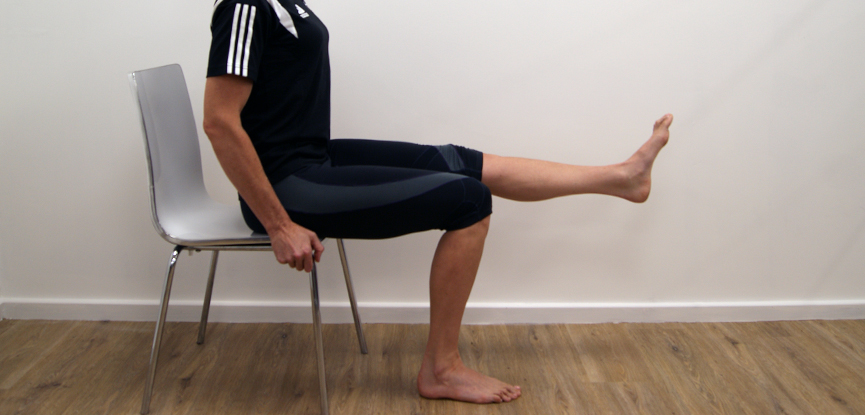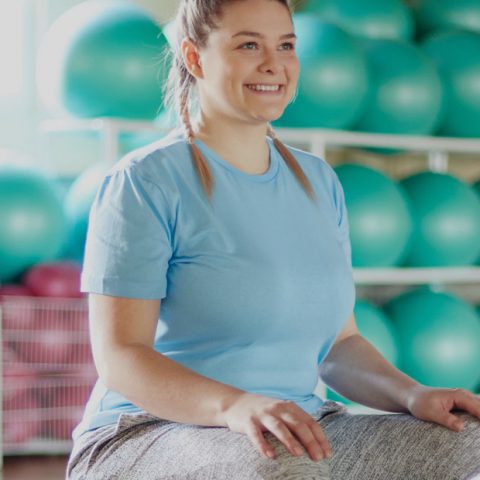The World Health Organisation states that since 1980 the number of obese people worldwide has almost doubled. In England, around 1 in 4 adults are currently obese. This epidemic is thought to be related to lifestyle habits, including poor diet and low physical activity levels, which in turn can be linked to other factors such as availability of cheap, fast food and the prevalence of labour-saving devices like dishwashers and remote controls.
Exercise can be difficult for those who are obese. Physical limitations include difficulty getting into specific positions or using equipment due to fat bulk, joint discomfort – particularly in the lower limb joints – due to the additional load, and low energy levels.
Psychological challenges are also common, including low mood and potential embarrassment when in fitness or sports environments such as the gym. However, as is widely known, health outcomes are poor for those who are obese, so improving physical activity habits and weight management are high on the health agenda.
Pilates can contribute to the Department of Health recommended an accumulation of 150 minutes of physical activity across the week and may be viewed as an achievable type of exercise for those who are obese and also potentially deconditioned. As obese people are at higher risk of health events, such as heart attack and stroke, it is important to ensure GP clearance is sought before the client commences a new exercise programme.

It should be noted that recommendations for physical activity with obese clients suggest that aerobic exercise, typically walking, is the best exercise type as it has the greatest calorie expenditure with the least possibility of injury. Whilst Pilates may add to the overall physical activity participation level of an individual, it is worth suggesting that taking up a walking programme, or indeed another preferred form of aerobic exercise, is the best option for weight management.
The Pilates exercises described below focus on adapting positions for comfort, and therefore address some of the physical limitations that may be experienced by obese individuals. The article also covers some general suggestions for exercising obese clients which can be applied to any exercise programme, including Pilates.
Getting down to and up from the floor can be difficult (and in some cases impossible) when the participant is very large. Getting up from the floor requires the ability to lift one’s own body weight and of course, when that weight is considerably more than is considered healthy, the leg muscles may well struggle.
This means that potentially the Pilates instructor may need to have a range of chair-based alternatives up their sleeve for those participants who are unable to get on and off the floor. As well as this, it’s a good idea to be aware of the therapy guidelines for teaching impaired clients to rise from the floor. You may not ever need to use these, but knowing what to do in the event of a tricky situation promotes confidence in the instructor and, in turn, the client’s trust in their instructor.
Assuming the client is able to transfer to the floor, some consideration needs to be given to the comfort, and indeed effectiveness, of lying positions. When the person is supine (on their back), you may find that their neck is overly extended to allow their head to rest on the floor. This can be corrected with a block or two under their head. The same is true when the person is lying in other positions; when prone, a block or two under their forehead can prevent uncomfortable neck flexion, and when lying on their side, a block or two under their ear can prevent their head hanging with the neck in lateral flexion.
Additionally, obese women, in particular, may find prone lying very uncomfortable due to having a large bust. Where possible, work the same muscle from an alternative lying (or seated) position. An example is prone back extensor work such as the breaststroke exercise. This could be replaced with a seated/kneeling dumb waiter exercise using a resistance band.

Often Pilates teachers coach neutral spine in supine lying by asking the person to locate their anterior superior iliac spine (bony protrusions on the front of the pelvis) and/or by placing the hands on the lower abdomen or in the gap between the lower back and the mat. It stands to reason that these teaching strategies may not work if the hip bones are difficult to find, and there is no gap between the lower back and the floor due to fat accumulation. Using visualisation, for example, rather than palpation techniques, might be more empathetic and helpful.
Relatedly, those who become Pilates instructors tend to be taught to use touch as a primary method of enhancing technique. Although one can argue that touch should always be used with care and with permission from the client, this skill should be used even more cautiously with obese participants. Some common-sense rules can be applied, such as touching the hands and feet to adjust limb position, and touching the shoulders to adjust the trunk position.
Balance can be adversely affected when people are very overweight, therefore when in standing, ensure clients have a wider base of support. Feet shoulder-width apart, instead of hip-width apart, can, therefore, be helpful. Another strategy is to stand the client near to the wall for additional external support. A wider base of support can also be applied to exercises in all fours; knees and hands may need to be wider than usual.
Obese people typically have a reduced range of movement compared to individuals with ‘normal’ body weight, due to the mass of fat surrounding the joints. Reduced range may be compounded by sedentary behaviour. Pilates with individuals of ‘normal’ body weight has the potential to improve range of movement, however, in obese clients, fat loss may be required before Pilates can have any impact on improving flexibility.
This is another reason why Pilates in conjunction with aerobic exercise should be encouraged. Any activity that involves fullest range flexion at the hip, for example, seated hamstring stretching, is likely to be challenging due to fat bulk around the abdomen. Having the leg further out to the side may accommodate this. In shell stretch, having the knees wider – with the feet remaining close together – creates more space between the client and the floor.
The limbs of those who are obese are usually heavy, and therefore any exercise that lifts the leg against gravity (such as side leg raise series or superman) will be disproportionally more challenging than in those who are not obese. Having pre-planned, less intense options is important, otherwise, the client may feel very demotivated and less likely to return to class. Common leverage principles can be applied; shortening levers reduces intensity.
Being obese puts additional pressure on the pelvic floor and may be associated with continence issues. Pilates traditionally encourages co-contraction of the pelvic floor (PF) when practising abdominal hollowing, so with this client group, it’s really just a case of maintaining this emphasis by consistently reminding people to contract their PF. Perhaps also include a few more exercises that work the PF than you would ordinarily. It might also be worth encouraging PF contractions as a home exercise, as evidence suggests that they should be done every day to be effective.
As highlighted earlier, lower limb joints, especially the ankles, knees and hips, as well as the lower back, can be adversely affected by obesity due to the additional mechanical stress. Whilst losing weight is probably the best outcome for these joints, the second-best solution is to strengthen the muscles surrounding them. In line with this, monkey squats can be used to strengthen the quadriceps and hamstrings thus ‘strengthening’ the knees. However, if knee pain is experienced, a non-weight-bearing alternative is seated knee extension.

The weight of the leg itself is usually sufficient to effectively challenge the target muscles. The client can sit further towards the back of the chair to make this exercise less challenging if needed.
Many obese people are hypertensive and taking medication to control this. Related to this there are two important considerations for adapting Pilates. Firstly, high-intensity isometric activities, such as the full plank, that are held for an extended period of time, should be minimised, due to the potential for temporarily increasing blood pressure. That said, it is unlikely that someone extremely obese would be comfortable doing this type of exercise, so our attention would be better served focusing on the second consideration.
Those people whose blood pressure is controlled with anti-hypertensive medication may experience postural hypotension when changing body position. This manifests itself as a feeling of light-headedness, the precursor to fainting, when the person changes from a seated to standing position, or indeed from lying to standing. It can be in part counteracted by not performing these transfers quickly, in combination with pumping the feet once the manoeuvre has been completed. Foot pumping contracts the calf muscles which aids venous return, thus normalising the temporary drop in blood pressure when changing body position.
In summary, adopting a regular physical activity programme is a health priority for obese individuals, and Pilates can add to the total weekly calorific expenditure. Pilates can easily be adapted to accommodate some of the challenges met by obese individuals. Moreover, a qualified Pilates instructor who has these adaptations at their fingertips will create a welcoming atmosphere for people who are often intimidated by the fitness environment.


